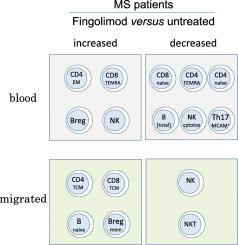当前位置:
X-MOL 学术
›
J. Neuroimmunol.
›
论文详情
Our official English website, www.x-mol.net, welcomes your feedback! (Note: you will need to create a separate account there.)
Selective modulation of trans-endothelial migration of lymphocyte subsets in multiple sclerosis patients under fingolimod treatment
Journal of Neuroimmunology ( IF 3.3 ) Pub Date : 2020-12-01 , DOI: 10.1016/j.jneuroim.2020.577392 Simon Hawke , Anna Zinger , Pierre-Georges Juillard , Karen Holdaway , Scott N. Byrne , Georges E. Grau
Journal of Neuroimmunology ( IF 3.3 ) Pub Date : 2020-12-01 , DOI: 10.1016/j.jneuroim.2020.577392 Simon Hawke , Anna Zinger , Pierre-Georges Juillard , Karen Holdaway , Scott N. Byrne , Georges E. Grau

|
Multiple sclerosis (MS) is an autoimmune disorder where auto-aggressive T cells target the central nervous system (CNS), causing demyelination. The trans-endothelial migration of leucocytes across the blood-brain barrier (BBB) is one of the earliest CNS events in MS pathogenesis. We examined the effect of the disease state and treatment with fingolimod on the transmigration of peripheral blood mononuclear cells (PBMCs) in an in vitro BBB model. Patients' leucocyte numbers, subsets and phenotypes were assessed by flow cytometry. As expected, fingolimod treatment induced a significant reduction in T cell and B cell numbers compared to untreated MS patients and healthy controls. Interestingly fingolimod led to a marked reduction of CD4+ and a significant increase in CD8+ cell numbers. In migrated cells, only CD3+ cell numbers were reduced in fingolimod-treated, compared to untreated patients; it had no effect on B cell or monocyte transmigration. T cells were then differentiated into naïve, effector and memory subsets based on their expression of CCR7. This showed that MS patients had increased numbers of effector memory CD4+ cells re-expressing CD45RA (TEMRA) and a decrease in central memory (CM) CD8+ cells. The former was corrected by fingolimod, while the latter was not. CM CD4+ and CD8+ cells migrated across BBB more efficiently in fingolimod-treated patients. We found that while fingolimod reduced the proportions of naïve CD19+ B cells, it significantly increased the proportions of these cells which migrated. When B cells were further stratified based on CD24, CD27 and CD38 expression, the only effect of fingolimod was an enhancement of CD24hiCD27+ B cell migration, compared to untreated MS patients. The migratory capacities of CD8hi Natural Killer (NK), CD8dim NK and NK-T cells were also reduced by fingolimod. While the disease-modifying effects of fingolimod are currently explained by its effect on reducing circulating auto-aggressive lymphocytes, our data suggests that fingolimod may also have a direct though differential effect on the trans-endothelial migration of circulating lymphocyte populations.
中文翻译:

芬戈莫德治疗多发性硬化患者淋巴细胞亚群跨内皮迁移的选择性调节
多发性硬化症 (MS) 是一种自身免疫性疾病,其中自身攻击性 T 细胞靶向中枢神经系统 (CNS),导致脱髓鞘。白细胞跨血脑屏障 (BBB) 的跨内皮迁移是 MS 发病机制中最早的 CNS 事件之一。我们在体外 BBB 模型中检查了疾病状态和芬戈莫德治疗对外周血单核细胞 (PBMC) 迁移的影响。通过流式细胞术评估患者的白细胞数量、亚群和表型。正如预期的那样,与未治疗的 MS 患者和健康对照相比,芬戈莫德治疗诱导了 T 细胞和 B 细胞数量的显着减少。有趣的是,芬戈莫德导致 CD4+ 显着减少和 CD8+ 细胞数量显着增加。在迁移的细胞中,与未接受治疗的患者相比,接受芬戈莫德治疗的患者仅减少了 CD3+ 细胞数量;对B细胞或单核细胞的轮回无影响。然后根据它们的 CCR7 表达将 T 细胞分化为初始亚群、效应亚群和记忆亚群。这表明 MS 患者重新表达 CD45RA (TEMRA) 的效应记忆 CD4+ 细胞数量增加,而中央记忆 (CM) CD8+ 细胞减少。前者被芬戈莫德纠正,而后者则没有。在芬戈莫德治疗的患者中,CM CD4+ 和 CD8+ 细胞更有效地迁移到 BBB。我们发现,虽然芬戈莫德降低了初始 CD19+ B 细胞的比例,但它显着增加了这些迁移细胞的比例。当根据 CD24、CD27 和 CD38 表达进一步对 B 细胞进行分层时,与未治疗的 MS 患者相比,芬戈莫德的唯一作用是增强了 CD24hiCD27+ B 细胞迁移。芬戈莫德还降低了 CD8hi 自然杀伤细胞 (NK)、CD8dim NK 和 NK-T 细胞的迁移能力。虽然目前芬戈莫德的疾病修饰作用可以通过其减少循环自身攻击性淋巴细胞的作用来解释,但我们的数据表明,芬戈莫德也可能对循环淋巴细胞群的跨内皮迁移具有直接但不同的影响。
更新日期:2020-12-01
中文翻译:

芬戈莫德治疗多发性硬化患者淋巴细胞亚群跨内皮迁移的选择性调节
多发性硬化症 (MS) 是一种自身免疫性疾病,其中自身攻击性 T 细胞靶向中枢神经系统 (CNS),导致脱髓鞘。白细胞跨血脑屏障 (BBB) 的跨内皮迁移是 MS 发病机制中最早的 CNS 事件之一。我们在体外 BBB 模型中检查了疾病状态和芬戈莫德治疗对外周血单核细胞 (PBMC) 迁移的影响。通过流式细胞术评估患者的白细胞数量、亚群和表型。正如预期的那样,与未治疗的 MS 患者和健康对照相比,芬戈莫德治疗诱导了 T 细胞和 B 细胞数量的显着减少。有趣的是,芬戈莫德导致 CD4+ 显着减少和 CD8+ 细胞数量显着增加。在迁移的细胞中,与未接受治疗的患者相比,接受芬戈莫德治疗的患者仅减少了 CD3+ 细胞数量;对B细胞或单核细胞的轮回无影响。然后根据它们的 CCR7 表达将 T 细胞分化为初始亚群、效应亚群和记忆亚群。这表明 MS 患者重新表达 CD45RA (TEMRA) 的效应记忆 CD4+ 细胞数量增加,而中央记忆 (CM) CD8+ 细胞减少。前者被芬戈莫德纠正,而后者则没有。在芬戈莫德治疗的患者中,CM CD4+ 和 CD8+ 细胞更有效地迁移到 BBB。我们发现,虽然芬戈莫德降低了初始 CD19+ B 细胞的比例,但它显着增加了这些迁移细胞的比例。当根据 CD24、CD27 和 CD38 表达进一步对 B 细胞进行分层时,与未治疗的 MS 患者相比,芬戈莫德的唯一作用是增强了 CD24hiCD27+ B 细胞迁移。芬戈莫德还降低了 CD8hi 自然杀伤细胞 (NK)、CD8dim NK 和 NK-T 细胞的迁移能力。虽然目前芬戈莫德的疾病修饰作用可以通过其减少循环自身攻击性淋巴细胞的作用来解释,但我们的数据表明,芬戈莫德也可能对循环淋巴细胞群的跨内皮迁移具有直接但不同的影响。



























 京公网安备 11010802027423号
京公网安备 11010802027423号